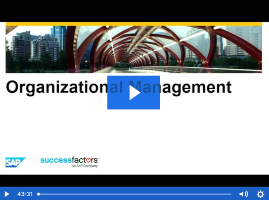Remote Work Amplifies the Need for Good Employee Experience
By Craig Powers, Research Analyst, SAPinsider
Employees are returning to offices in some parts of the world after more than a year away, but remote work is likely to become a staple for many businesses. In a remote environment, employee experiences can differ dramatically as people work on the same projects as their peers but in different locations and under varying circumstances. SAPinsider’s State of Human Experience in the Workplace Benchmark Report, published in June 2021, found that increasing remote work and workplace disruption was a driving force for employee experience strategy for 54% of respondents.
Other motivating factors for employee experience initiatives include organizational change, employee retention, and competition for talent. However, remote work was the overwhelming driver for employee experience strategy (see Figure 1).
Explore related questions
To ensure quality experience when most employees were required to work from home beginning in the spring of 2020, the concept of connection became important, and technologies like Microsoft Teams and Zoom became more commonplace. Those video and connectivity platforms were put in place to emulate, at some level, an in-person work environment and keep employees engaged. This aligns with the objective that survey respondents rated as the most important for employee experience strategies: increasing employee productivity.
Efforts to improve employee experience may be considered sentimental in nature as opposed to strategic, but the truth is companies want to achieve recognizable return on their people investment, and investment in experience is often about enabling more productive workers. So that begs the question — how are companies investing in employee experience?
First, it’s important to note that human resources (HR) departments are primarily leading employee experience efforts — 83% of respondents said HR is either highly responsible or very highly responsible for employee experience. However, put that into the context of HR being the last in line for investment, as we highlighted in our general State of the Market survey earlier this year, and budget still remains a barrier.
Figure 1: Which of the following are most responsible for driving your organization’s current employee experience strategy?

Budget constraints were indicated by 56% of respondents as a hindrance to investment in employee experience management processes or technology, with another 41% saying the company has more important priorities.
Still, with the rise in remote work, interest in employee experience is growing — 65% of respondents said their organization’s focus is greater in this area than it was two years ago. In addition, changes in work and workplace caused by the global pandemic have accelerated technology adoption to support employee experience management at 61% of respondent organizations.
The Employee Experience Technologies in Use — and Those On The Way
Recruiting is the first employee experience touchpoint, and it has been at the forefront of technology adoption. A majority of respondent organizations (66%) said they are already using or are currently implementing a recruiting tool. Unsurprisingly, 65% are using or implementing conferencing or remote connectivity solutions, a number that has no doubt risen in the past year. Nearly all of the remaining respondents said they are planning to implement or are evaluating recruiting and conferencing solutions.
Mobile access to work and pay data is in use or being implemented at over half of respondent organizations. Mobile access to work and pay data, recruiting tools, and conferencing solutions make up the first wave of employee experience technology proven by widespread adoption.
In the second wave companies are exploring analytics solutions, workforce management tools, and employee collaboration tools. While our research shows that all of these tools are currently being utilized by some companies, a majority of organizations remain in the evaluation phase of second wave solutions.
Comprehensive employee experience management solutions are still new to the market. SAP only rebranded its human capital management (HCM) solution set to support the concept of human experience management (HXM) two years ago and is only at the beginning of providing a full-fledged experience toolkit. Adoption so far is low — just 10% of respondents indicated using or implementing an end-to-end employee experience solution. However, that area is looking to grow, with 71% of respondent organizations planning to implement or evaluating end-to-end solutions (see Figure 2).
Figure 2: Employee experience tools and technologies

What Does This Mean for SAPinsiders?
How are organizations succeeding in providing high quality employee experience? We examined subsets of respondents that rated their employee experience efforts highly and put together these key takeaways and recommendations. For a more comprehensive analysis and more guidance, download the full State of Human Experience in the Workplace Benchmark Report.
Quantify the value of employee experience. Many of the requirements around employee experience are measurable through net promoter score such as turnover rates, absenteeism, employee performance, and employer brand. Identifying the connection between happier employees and better metrics will be key to unlocking the biggest roadblocks to investing in experience, which respondents identified as budget constraints and prioritization. If your organization does not have the means to automate this analysis, look at the data available such as performance reviews, annual surveys, or exit interviews. Connecting that information to your key experience requirements can help build support for experience improvements.
Begin the employee experience journey before the offer letter is signed. Recruiting solutions are already central to what SAPinsiders are doing in the area of employee experience management, and those that haven’t already purchased or implemented recruiting software are aware of its need. This also ties back to employer brand being a top requirement — the recruiting process is a place where non-employees gain the most insight into how your company operates. Ensuring recruiting is a positive experience should have a positive impact on your organization’s brand.
Adapt to changes in the workplace to improve experience overall. Companies more focused on adjusting to remote work experience are more likely to provide better employee experience overall. Among those organizations with above average employee experience, 88% have accelerated adoption of employee experience solutions as a result of changes in work and workplaces caused by the global pandemic, compared to 42% of the respondents at organizations with average or below average employee experience.
Give your employees access to the data they need. Almost 40% of respondents with above average employee experience are at companies currently using workforce management solutions (WFM) — twice the rate of those with average or below average experiences. Respondents with above average experience are also nearly twice as likely to use applicant tracking systems (ATS). Both WFM systems and ATS are designed to give easier access to certain types of information — be it their own data or the data of someone they are managing or recruiting. Having this type of access makes experiences better and is likely going to lead to higher productivity. It can also increase retention or shorten the recruiting cycle.






